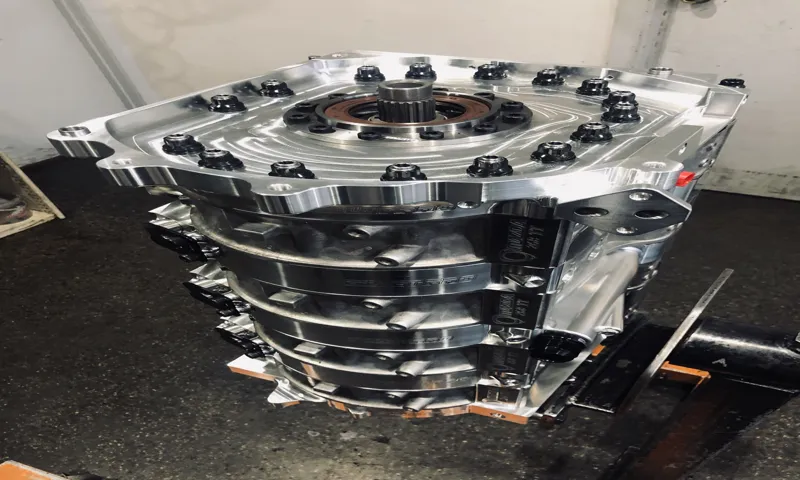Have you ever heard of a 4 rotor engine? You may have seen it in high-performance cars or even in racing sports. But what exactly is it? A 4 rotor engine is a type of internal combustion engine that uses four rotors to generate power. Unlike traditional engines, a 4 rotor engine has a unique design that allows it to produce high levels of horsepower and torque, making it popular among motorsports enthusiasts and those who crave speed.
To understand why a 4 rotor engine is so different, it’s essential to know how it works. Instead of having pistons that move up and down, a rotor engine uses rotors that spin in a circular motion within a housing. These rotors have three sides, and as they spin, they work together to compress air and fuel, which then ignites and produces power.
The result is a smooth and efficient engine that can generate impressive amounts of power with less weight and fewer moving parts. One of the most significant advantages of a 4 rotor engine is its high RPM (rotations per minute), allowing it to output exceptional performance. A 4 rotor engine can easily reach RPMs of up to 10,000, which translates to more horsepower and torque, making it an excellent choice for vehicles that require speed and agility.
It’s a powerful engine that is also incredibly lightweight and compact, making it a favourite choice among race car drivers. In conclusion, a 4 rotor engine is a unique type of internal combustion engine that is known for its high levels of horsepower and torque. Its design uses rotors to generate power instead of pistons, resulting in a lightweight and efficient engine that is perfect for high-performance vehicles.
So, if you’re planning to enter the world of motorsports or merely love the thrill of speed, a 4 rotor engine may be the perfect choice for you.
Table of Contents
Overview
When it comes to high-performance engines, the 4 rotor is one of the most impressive options out there. As the name suggests, a 4 rotor engine features four rotors, making it a type of rotary engine. Unlike traditional piston engines, rotary engines use a unique design that allows for higher RPMs and more power output.
The 4 rotor engine is known for its impressive horsepower capabilities and its distinct sound. It’s a popular choice among motorsports enthusiasts and is commonly used in racing applications. While 4 rotor engines are less common than other types of engines, they remain a popular option for those seeking extreme performance.
If you’re looking to learn more about the exciting world of high-performance engines, the 4 rotor engine is definitely worth exploring.
Definition of a 4 rotor engine
A 4 rotor engine, also known as a quad-rotor engine, is a type of internal combustion engine that has four rotors in its rotor housing. Each rotor has three faces, which means that a 4 rotor engine has a total of 12 pairs of combustion chambers, making it a high-performance engine. It is commonly used in high-performance vehicles such as sports cars and racing cars where power and performance are key.
The operation of a 4 rotor engine is unique compared to other engines due to its Wankel design. Instead of traditional pistons and cylinders, the rotors of a 4 rotor engine rotate around the crankshaft, creating a more efficient combustion process. Due to its design, a 4 rotor engine can produce a significant amount of horsepower and torque, making it a popular choice for performance enthusiasts.
Overall, a 4 rotor engine is a powerful and unique engine that provides high performance in the world of motorsports.

Explanation of the rotary engine
The rotary engine is a fascinating invention that has been the subject of much curiosity over the years. At its core, the rotary engine works by compressing air and fuel inside a spinning chamber. Unlike a traditional engine, which uses pistons to compress this mixture, the rotary engine uses a series of triangular rotors that rotate around a central shaft.
As the rotors spin, they compress the air and fuel, creating the combustion necessary to power the engine. This unique design has several advantages over traditional engines, including higher power output, smoother operation, and a smaller size and weight. Nevertheless, there are some drawbacks, such as higher fuel consumption and lower efficiency due to the need for lubrication and sealing.
Despite these limitations, the rotary engine remains a fascinating and innovative piece of engineering that has captured the imagination of many over the years.
History of 4 rotor engines
A 4 rotor engine is an unusual type of internal combustion engine that uses four rotors instead of the conventional piston-cylinder design. The 4 rotor engine was first developed by Felix Wankel in the 1950s. It works by compressing air and fuel mixture in a rotating chamber, which creates motion and generates power.
These engines have some distinct advantages, such as being lighter, more powerful, and fuel-efficient than their 2- or 3-rotor cousins. However, they also have some challenges, such as complexity, high manufacturing cost, and the need for specialized expertise for maintenance. Despite these drawbacks, 4 rotor engines have become famous in motorsports, especially in the legendary Mazda 787B that won the 24 Hours of Le Mans race in 199
Today, engineers and enthusiasts continue to explore the potential of 4 rotor engines in various applications, from cars and planes to boats and generators.
Mazda’s development of the 4 rotor engine
Mazda’s development of the 4 rotor engine is one of the most fascinating stories in the history of automotive engineering. The 4 rotor engines were first introduced in the 1960s, and Mazda was the first automaker to develop a commercial 4 rotor engine. It wasn’t until the 1980s, however, that Mazda’s engineers began working on the 4 rotor engine that would become the centerpiece of the company’s racing and sports car efforts.
The development of the 4 rotor engine was a long and complex process, requiring the development of new materials, new manufacturing techniques, and new design concepts. Despite these challenges, the engineers at Mazda persisted, and the result was a revolution in the automotive world. The 4 rotor engine was lighter and more powerful than any other engine of its time, and it quickly became the engine of choice for many racing teams and sports car enthusiasts.
Today, Mazda’s legacy lives on, as the company continues to develop and refine its 4 rotor engine technology, pushing the boundaries of automotive design and performance.
Uses in motorsports and racing
The history of 4-rotor engines in motorsports and racing dates back to the 1960s when Felix Wankel invented the rotary engine. The rotary engine is a unique type of internal combustion engine that uses rotors instead of pistons to produce power. The 4-rotor engine is a high-performance type of the rotary engine, and it has been successfully used in motorsports and racing over the last few decades.
These engines offer an exceptional power-to-weight ratio, making them ideal for use in racing and other high-performance applications. They also have a unique sound and are known for their ability to rev to high RPMs, providing excellent acceleration and speed. Mazda is one of the most well-known manufacturers that have utilized 4-rotor engines in motorsports, and their RX-792P car won the IMSA GT Championship in 199
Today, 4-rotor engines continue to be used in various forms of racing, including drag racing, drifting, and circuit racing. It is an exciting time for 4-rotor engines in motorsports as advancements in technology continue to push the boundaries of what is possible.
Popularity in the tuning community
Popularity in the tuning community 4 rotor engines have been a favorite amongst car enthusiasts and the tuning community for decades. Their unique sound and power output make them a desirable option for those looking to push their performance limits. The first 4 rotor engine was built by Mazda in the 1980s for their Group C racing program.
It quickly gained popularity with its impressive performance and reliability. The engine’s small displacement and high output made it a dominant force in the racing world. Soon after, the engine was adapted for use in street cars, and its popularity soared.
Today, many tuning shops specialize in building and tuning 4 rotor engines for street and track use. The unique sound and power output of these engines make them a favorite amongst car enthusiasts and tuning community. Many consider the 4 rotor engine to be the ultimate expression of rotary engine technology.
With its rich history and undeniable performance, it’s easy to see why 4 rotor engines are still popular to this day.
Advantages and Disadvantages
A 4 rotor engine, also known as a rotary engine, is a type of internal combustion engine in which the rotating motion of a triangular rotor compresses the air/fuel mixture inside the engine. One major advantage of a 4 rotor engine is its compact size and lightweight design, which provides the potential for high power output that is crucial for racing applications. However, these engines tend to have lower fuel efficiency and can be less reliable than their traditional piston counterparts.
Additionally, they require a unique set of maintenance skills, increasing costs and limiting availability for widespread use in everyday automobiles. Overall, a 4 rotor engine can be an excellent option for those in search of high performance capabilities but may not be suitable for those looking for practicality and fuel efficiency.
Benefits of a 4 rotor engine
A 4 rotor engine has several advantages but it also comes with its own set of disadvantages. One of the main benefits of a 4 rotor engine is that it produces more power than a similar sized conventional engine. This makes it ideal for high performance vehicles such as sports cars and race cars.
Additionally, a smaller engine means that the total weight of the vehicle is reduced, improving overall handling and agility. Another strength of a 4 rotor engine is its smoothness and balance, which is due to the design of the engine itself. However, a disadvantage of a 4 rotor engine is that it requires more maintenance than a conventional engine.
This is due to the fact that the engine has more moving parts and therefore requires more attention. Additionally, 4 rotor engines tend to be more expensive, which can make them less accessible for individuals on a budget. Overall, a 4 rotor engine is a great option for those seeking high performance but it does come with its own set of trade-offs.
Drawbacks of a 4 rotor engine
A 4 rotor engine has many advantages, such as providing high power output in a smaller and more compact package, but it also has some drawbacks to consider. One of the main disadvantages of a 4 rotor engine is that it tends to be less efficient than other engines of similar size. This is because the combustion process in a rotary engine is not as efficient as it is in a traditional piston engine.
Another drawback of a 4 rotor engine is its high fuel consumption, which can drive up the cost of ownership over time. Additionally, the rotary engine requires more frequent maintenance than a conventional engine, which can be a hassle for owners. Despite these drawbacks, many enthusiasts still love the unique sound and performance of a 4 rotor engine, and some even consider them worth the extra cost and maintenance.
Overall, it is important to carefully consider the advantages and disadvantages of a 4 rotor engine before deciding if it is the right choice for you.
Conclusion
In essence, a 4 rotor engine is like having four miniature hurricanes storming through your vehicle, generating an unbeatable amount of power and performance. It’s a symphony of pistons dancing in perfect harmony, producing a unique and unforgettable sound that only the rotary engine can provide. So, whether you’re a gearhead, speed demon, or just someone who loves the thrill of the ride, the 4 rotor engine is the ultimate embodiment of engineering brilliance, delivering a driving experience that simply cannot be replicated.
“
FAQs
What is a 4 rotor engine?
A 4 rotor engine is a type of engine that has four rotors instead of the standard two in a traditional rotary engine.
What are the benefits of a 4 rotor engine?
Some benefits of a 4 rotor engine include higher horsepower, improved performance, and increased reliability.
How does a 4 rotor engine work?
A 4 rotor engine operates similarly to a traditional rotary engine, with each rotor rotating around a central axis to create power.
What types of vehicles use 4 rotor engines?
4 rotor engines are commonly used in high-performance racing vehicles, such as those used in drifting competitions.
How much horsepower can a 4 rotor engine produce?
The horsepower output of a 4 rotor engine varies depending on several factors, but it can typically produce upwards of 1,000 horsepower or more.
What is the difference between a 4 rotor engine and a traditional rotary engine?
The main difference between a 4 rotor engine and a traditional rotary engine is the number of rotors; a traditional rotary engine has two, while a 4 rotor engine has four.
Are 4 rotor engines reliable?
Yes, 4 rotor engines are generally considered to be reliable, especially when properly maintained and cared for.



